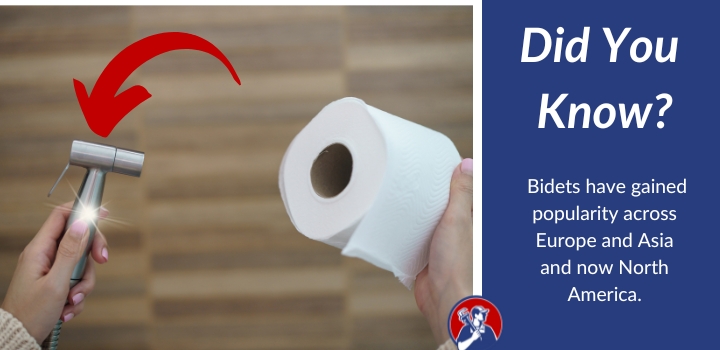
What’s a bidet? You’ve heard about it. Maybe even saw the word and wondered how it’s pronounced. It’s “bih-day” by the way.
Well, you’ve come to the right place. In this article, we will plunge into the fascinating world of the toilet with its own mini-shower – bidets.
We’ll start by briefly exploring the history of the bidet, and how they have evolved over time. Then, we’ll talk about the various types of bidets available and their benefits.
Let’s get down to business.
| What's In This Guide? | |
|---|---|
|
|
|
What is a Bidet Toilet?
A bidet is a bathroom fixture that provides an efficient and hygienic way to cleanse oneself after using the toilet. Designed to assist in personal hygiene, instead of using toilet paper, bidets provide an effective and environmentally friendly solution for personal hygiene.
Do you have specific questions about bidets? See our bidet guides:
- How does a bidet work
- How to install a bidet
- How to use a bidet as a woman
- How to use a bidet as a man
- How do dry yourself after using a bidet
- How to clean your bidet
- The best bidet converter kits, reviewed.
What is the Main Purpose of Bidets?
Bidets serve as an efficient method for cleaning one’s genitalia and anus area after using the restroom. They use water pressure instead of relying on dry toilet paper or wet wipes, which can cause irritation or discomfort for some individuals.
This gentle cleansing process not only promotes better hygiene but also reduces environmental waste caused by excessive toilet paper consumption.
Eco-Friendly Alternative
One major advantage of using a bidet is its positive impact on the environment. Business Insider reported that it takes an astonishing 37 gallons of water to manufacture one roll of toilet paper.
By incorporating bidets into our daily routines, we can significantly reduce our carbon footprint while still maintaining optimal cleanliness.
Variety in Design and Functionality
Bidets come in various designs that cater to different preferences and needs. From standalone units that resemble traditional toilets with built-in faucets to attachments that can be added to existing toilets – there’s a bidet option suitable for everyone.
Want a deeper dive, watch this video on bidets:
Tracing back centuries, let’s delve into the beginnings of this distinctive bathroom fixture.
Get Fast, Local Plumbing Service
Connect with an expert plumber in your local area to tackle any job – big or small. Find help with leaks, clogs, or full installations.
Select your service category on the form, provide your details, and an expert plumber will be in touch!
Plumbing Navigator is an informational site that connects visitors with local plumbers but does not directly provide plumbing services or operate as a licensed company.
History of Bidets
Tracing its roots to the 1700s in France and Italy, traditional bidets were initially designed as a simple basin for washing one’s private areas.
Origins in France and Italy
Bidets were first introduced in France during the early 18th century by French furniture makers who sought to create a more convenient method for personal hygiene.
The word “bidet” is derived from the French term meaning “small horse,” referring to how users would straddle the fixture like they would when riding a horse (bet you didn’t know that!).
Around this same period, Italian inventors also began developing their own versions of bidets.
Development of Bidet Technology
As technology advanced, so did bidet designs. In the late 19th century, advancements in plumbing allowed for water jets to be incorporated into bidets instead of relying on manual pouring or splashing techniques used previously.
This made them even more effective at cleaning sensitive areas without causing irritation or discomfort.
- Mechanical Bidets: These early models relied on manually operated valves that controlled water flow through an adjustable sprayer.
- Electronic Bidets: By incorporating electronic controls in mid-20th-century Japan, these modern units provided features such as temperature control and adjustable spray patterns (you might call it a “smart toilet”).
- Add-on Units & Attachments: In recent years, add-on units have become popular due to their affordability and ease of installation, allowing users to convert their existing toilets into bidets.
Global Popularity of Bidets
Bidets gained widespread acceptance in Europe and Asia throughout the 20th century.
In countries like Japan, South Korea, and Italy, modern bidet usage is commonplace in both private homes and public restrooms.
However, it wasn’t until recently that they began gaining traction in North America as homeowners started recognizing the benefits of improved hygiene and reduced toilet paper consumption.
As these bathroom fixtures have evolved over time their purpose remains the same – providing a safe and effective way to keep clean.
Key Takeaway:
Bidets were first introduced in France and Italy during the 1700s as a more convenient method for personal hygiene. Bidets have gained popularity across Europe and Asia and now North America.

Types of Bidets
There are several types of bidets available in the market, each catering to different needs and preferences.
The main categories include stand-alone units, integrated units, add-on units, and bidet attachments. Each type has its unique features and benefits that can enhance your bathroom experience.
Stand-Alone Units
A stand alone bidet is a separate fixture installed next to the toilet. These traditional bidets require additional space in your bathroom but offer a dedicated cleansing station for personal hygiene.
Stand-alone units typically come with adjustable water pressure settings and may have warm water options as well.
Integrated Units
Integrated bidet toilets, also known as smart toilets or all-in-one toilets, combine both the toilet seat and the bidet into one unit.
These modern fixtures save space by eliminating the need for an additional plumbing fixture while offering advanced features such as a heated seat, water heater settings, warm air dryer, deodorizers, and even remote controls (a complete “Tushy Spa!”).
Add-On Units & Bidet Attachments
- Toilet Seat Bidets: A bidet seat replaces your existing toilet seat with one that includes built-in spray nozzles for easy cleaning after using the restroom. They often feature adjustable water pressure, temperature settings, and air drying options.
- Bidet Attachments: A more affordable option without replacing the entire toilet seat is a bidet attachment. These devices attach directly to your existing toilet seat or under the rim of the bowl and connect to your bathroom’s water supply. They typically offer basic features such as adjustable spray angles and water pressure controls.
- Handheld Bidet Sprayer: This simple bidet toilet attachment offers a similar function but isn’t as convenient.
In addition to these main types of bidets, there are also portable bidets or travel bidets that can be taken on the go for personal hygiene.
When selecting a bidet, factors like space availability in the bathroom, cost, desired functions, and ease of setup must all be taken into account. See this post for complete instructions on how to install a bidet.
Key Takeaway:
Different varieties of bidets exist, ranging from standalone models to integrated designs, add-ons, and attachments. Each type has its unique features and benefits that can enhance your bathroom experience.
How Do Bidets Work?
Bidets are designed to provide a gentle and effective cleansing experience for users after using the toilet. They work by using water pressure to clean the genitalia and anus area, offering an alternative or supplement to traditional toilet paper usage. See this post for more details on exactly how they work.
Water Pressure
The primary function of a bidet is its ability to deliver water at varying pressures for cleaning purposes. Most modern bidets come with adjustable settings that allow users to control the intensity of the spray according to their preference.
Nozzle Positioning
Many bidet models feature adjustable nozzle positions, enabling users of different body shapes and sizes to find their optimal setting for thorough cleaning.
Temperature Control
A key aspect of ensuring comfort while using a bidet is having control over water temperature. Cold water may be uncomfortable or even shocking during use; therefore, many contemporary bidets offer warm-water options as well as customizable temperature settings so that each individual can choose what feels best for them.
Mixing Valves & Heating Elements
- Mixing Valves: Some bidets utilize mixing valves that blend hot and cold water from separate sources (usually your home’s existing plumbing) before reaching the nozzle(s).
- Heating Elements: Other bidets come with built-in heating elements that heat the water internally. These models typically have a small reservoir to store pre-heated water.
Drying Features
Some bidet models also include drying features such as warm air dryers or even oscillating nozzles which help remove excess moisture after washing. This can be particularly helpful for those with a limited range of movement.
With numerous benefits such as improved cleanliness, reduced reliance on toilet paper, and increased comfort during personal care routines, many individuals find that incorporating a bidet into their bathroom setup offers many benefits.
Key Takeaway:
Bidets have adjustable settings for water pressure, nozzle positioning, temperature control, and drying features that enhance personal hygiene and comfort.
Benefits of Using a Bidet
Using a bidet comes with numerous advantages that not only promote personal hygiene but also contribute to environmental sustainability. Some of the key benefits include:
- Reduced toilet paper usage
- Better personal hygiene
- Gentler on sensitive skin
- Easier for people with limited mobility
- Potential cost savings
Despite the advantages, there are a few potential risks when using a bidet.
Key Takeaway:
Using a bidet has numerous benefits such as reducing toilet paper usage, promoting better personal hygiene, being gentler on sensitive skin, and aiding people with limited mobility.
Risks Associated with Bidets
While bidets offer numerous benefits, there are a few medical concerns associated with their use.
Medical Concerns
- Hemorrhoids: People suffering from hemorrhoids should exercise caution while using a bidet as high-pressure water streams might exacerbate their condition. Opt for gentler settings and consult your doctor for advice on whether using a bidet is suitable for you.
- Pregnancy & postpartum care: Pregnant women and those who have recently given birth may find bidets helpful in maintaining hygiene. Check with your healthcare provider before using.
- Urinary tract infections (UTIs): While there is no direct evidence linking bidet use with an increased risk of UTIs, some experts believe that improper usage could potentially contribute to the development of such infections.
Key Takeaway:
Bidets provide a range of advantages, yet it’s important to understand there are some potential risks. To minimize these risks always follow proper usage guidelines and talk to your doctor.
Get Fast, Local Plumbing Service
Connect with an expert plumber in your local area to tackle any job – big or small. Find help with leaks, clogs, or full installations.
Select your service category on the form, provide your details, and an expert plumber will be in touch!
Plumbing Navigator is an informational site that connects visitors with local plumbers but does not directly provide plumbing services or operate as a licensed company.
Bidet FAQs
What is the point of a bidet?
The primary purpose of a bidet is to clean and refresh the perianal area after using the toilet, providing better hygiene and comfort.
How does a bidet work?
Think of a bidet as a toilet bowl with a mini-shower. It sprays water that cleans your bottom.
Is a bidet more sanitary than wiping?
Yes, bidets are considered more sanitary than wiping with toilet paper as they provide thorough cleansing by removing residual feces that may cause irritation or infection.
Why don’t Americans use bidets?
The answer is simple, we haven’t been made aware of them. If we knew what they were and how effective they are, more Americans would use them.
Final Thoughts on Bidets
Bidets have been around for centuries and come in various types, including standalone units and integrated options.
So, if you’re looking for a cleaner way to maintain personal hygiene after using the restroom, consider the Bidet.
Meet Your Plumbing Navigator

About Plumbing Navigator
We’re passionate about all things plumbing, and love sharing tips, “how-to”, and reviewing the latest products to help make your project a success!
Learn More Plumbing Tips
Want to tackle more plumbing projects? Check out these helpful guides!






